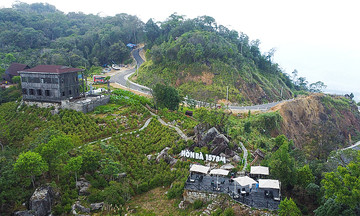According to captains and cruise industry experts, the main causes of fatalities on cruise ships are falling overboard, capsizing due to large waves, collisions with other vessels or stationary objects, and sinking or flooding that traps passengers inside.
 |
A cruise ship on Ha Long Bay. Photo: *Lux Group* |
DAN Boater, an international organization providing emergency medical services and maritime safety resources, along with Dr. Pham Ha, Chairman of LuxGroup (which owns 12 vessels, including day boats and overnight cruise ships operating in Lan Ha Bay, Ha Long Bay, and Nha Trang), offer essential safety advice for cruise travelers.
Before your trip, understand the itinerary, including the duration, destinations, expected experiences, and any precautions.
According to LuxGroup's Chairman, safety briefings are standard procedure before departure. Pay close attention to the locations of life-saving equipment, emergency exits, and restricted areas. In any unusual situation, remain calm and follow instructions.
Life jackets are provided in cabins and on deck. Wear them during the voyage, especially for activities like kayaking, boarding small boats, or swimming in deep water. Avoid wearing life jackets inside enclosed vessels, as they can hinder movement and escape during flooding.
Travel blogger and cruise safety expert Nick Fabbri advises against traveling on an empty stomach, especially in rough seas. However, avoid eating on board to minimize seasickness. It's best to eat before the trip.
For longer cruises, inform the crew about any health conditions, dietary restrictions, or chronic illnesses like asthma, epilepsy, diabetes, heart conditions, or allergies. This allows the crew to provide appropriate support and prevent potential incidents. If prone to seasickness, carry extra medication in case of vomiting.
During the trip, stay away from railings. Standing near railings, climbing onto outer decks for photos, or inattention during turns can lead to accidents. Children require constant adult supervision.
Susanna Botkin, an American cruise travel expert, identifies slips and falls as a leading cause of passenger injuries. Decks can be slippery, especially after rain or during travel. Wear non-slip shoes and avoid walking barefoot or in flip-flops. Older adults or those with balance issues should minimize movement while the ship is underway.
While the ship is moving, remain seated, avoid horseplay, and stay away from the edges. Refrain from alcohol to maintain alertness.
"To avoid risks, passengers should not touch, adjust, or tamper with anything on board without consulting the crew," advises Wally Moran, a former American ship captain.
In emergencies like rough seas or strong winds, hold onto railings or fixed objects, and remain calm. Composure is crucial for effective responses, especially during a sinking. Larger ships typically sink slowly, allowing time for preparation.
Immediately locate life jackets, life rafts, or any buoyant objects like wooden planks, barrels, or plastic containers. Large plastic bags can be inflated and tied together as makeshift flotation devices.
DAN Boater recommends launching life rafts and gathering essential supplies if the ship is in danger of sinking. Board the rafts one by one in an orderly manner to prevent capsizing. If unable to reach a raft, jump overboard while holding a flotation device in front of your chest to avoid submersion.
After entering the water, swim away from the sinking ship to avoid being pulled down by the vortex. Rescue teams usually respond quickly to large cruise ship incidents, so stay near the scene to be easily located.
While awaiting rescue, focus on those already safe and assist anyone still trapped. Use any means to signal for help to increase the chances of survival and timely rescue.
Tuan Anh












